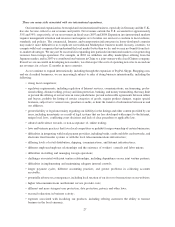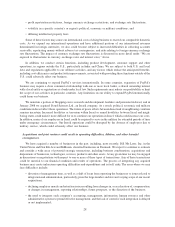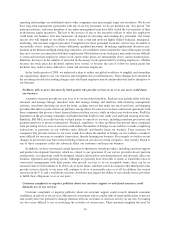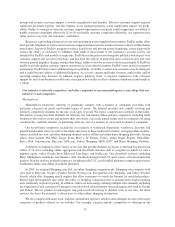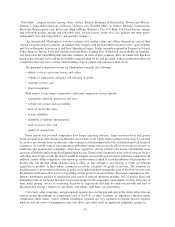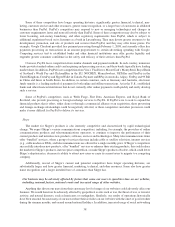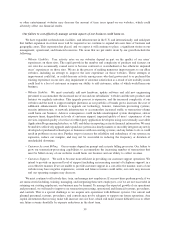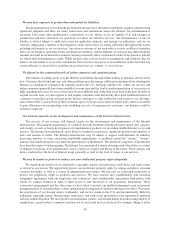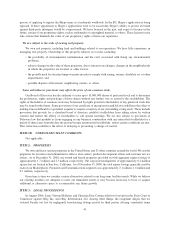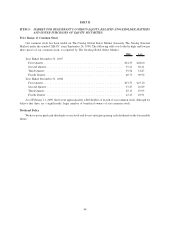eBay 2008 Annual Report Download - page 43
Download and view the complete annual report
Please find page 43 of the 2008 eBay annual report below. You can navigate through the pages in the report by either clicking on the pages listed below, or by using the keyword search tool below to find specific information within the annual report.prompt and accurate customer support to resolve irregularities and disputes. Effective customer support requires
significant personnel expense, and this expense, if not managed properly, could significantly impact our profit-
ability. Failure to manage or train our customer support representatives properly could compromise our ability to
handle customer complaints effectively. If we do not handle customer complaints effectively, our reputation may
suffer and we may lose our customers’ confidence.
Because it is providing a financial service and operating in a more regulated environment, PayPal, unlike eBay,
must provide telephone as well as email customer support and must resolve certain customer contacts within shorter
time frames. As part of PayPal’s program to reduce fraud losses and prevent money laundering, it may temporarily
restrict the ability of customers to withdraw their funds if those funds or the customer’s account activity are
identified by PayPal’s risk models as suspicious. PayPal has in the past received negative publicity with respect to its
customer support and account restrictions, and has been the subject of purported class action lawsuits and state
attorney general inquiries alleging, among other things, failure to resolve account restrictions promptly. If PayPal is
unable to provide quality customer support operations in a cost-effective manner, PayPal’s users may have negative
experiences, PayPal may receive additional negative publicity, its ability to attract new customers may be damaged,
and it could become subject to additional litigation. As a result, current and future revenues could suffer, and its
operating margins may decrease. In addition, negative publicity about, or negative experiences with, customer
support for any of our businesses could cause our reputation to suffer or affect consumer confidence in our brands as
a whole.
Our industry is intensely competitive, and other companies or governmental agencies may allege that our
behavior is anti-competitive.
Marketplaces
Marketplaces businesses currently or potentially compete with a number of companies providing both
particular categories of goods and broader ranges of goods. The Internet provides new, rapidly evolving and
intensely competitive channels for the sale of all types of goods. We expect competition to intensify in the future.
The barriers to entry into these channels are relatively low and current offline and new competitors, including small
businesses who want to create and promote their own stores, can easily launch online sites at a nominal cost using
commercially available software or partnering with any one of a number of successful ecommerce companies.
Our broad-based competitors include the vast majority of traditional department, warehouse, discount, and
general merchandise stores (as well as the online operations of these traditional retailers), emerging online retailers,
online classified services, and other shopping channels such as offline and online home shopping networks. Among
others, these include: Wal-Mart, Target, Sears, Macy’s, JC Penney, Costco, Office Depot, Staples, OfficeMax,
Sam’s Club, Amazon.com, Buy.com, AOL.com, Yahoo! Shopping, MSN, QVC, and Home Shopping Network.
A number of companies offer a variety of services that provide channels for buyers to find and buy items from
sellers of all sizes, including online aggregation and classifieds websites such as craigslist (in which we own a
minority equity stake), Google Base, Microsoft Live Expo, and Oodle.com. Our classifieds websites, including
Kijiji, Marktplaats, mobile.de, and Gumtree, offer classifieds listings in the U.S. and a variety of local international
markets. In many markets in which it operates, including in the U.S., our classified platforms compete against more
established online and offline classifieds platforms.
In 2005, we acquired Shopping.com Ltd., an online shopping comparison site. Shopping.com competes with
sites such as Buy.com, Google’s Product Search, Nextag.com, Pricegrabber.com, Shopzilla, and Yahoo! Product
Search, which offer shopping search engines that allow consumers to search the Internet for specified products.
Recent legal developments may affect the utility of shopping comparison sites if manufacturers begin requiring
more uniformity in product pricing. In addition, sellers are increasingly utilizing multiple sales channels, including
the acquisition of new customers by paying for search-related advertisements on search engine sites such as Google
and Yahoo!. We use product search engines and paid search advertising to channel users to our sites, but these
services also have the potential to divert users to other online shopping destinations.
We also compete with many local, regional, and national specialty retailers and exchanges in each of the major
categories of products offered on our websites. For example, category-specific competitors to offerings in our
35




